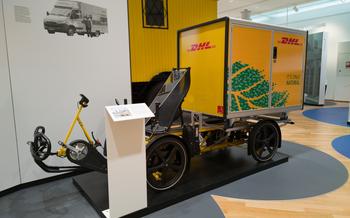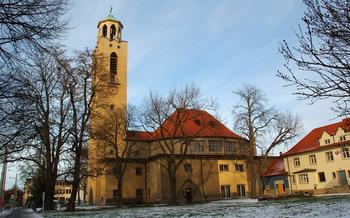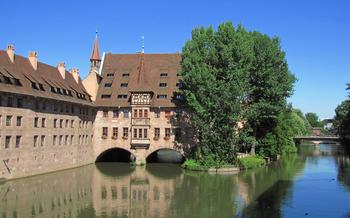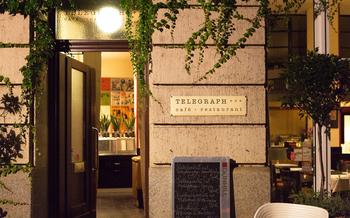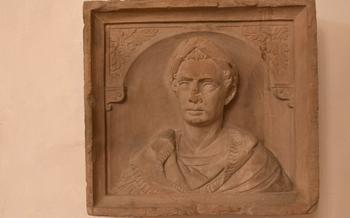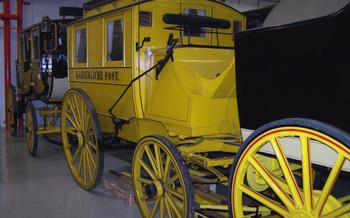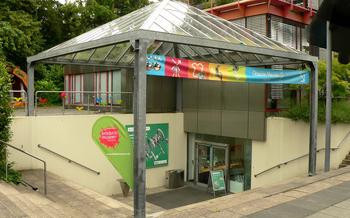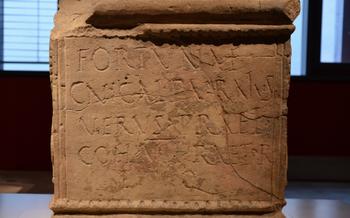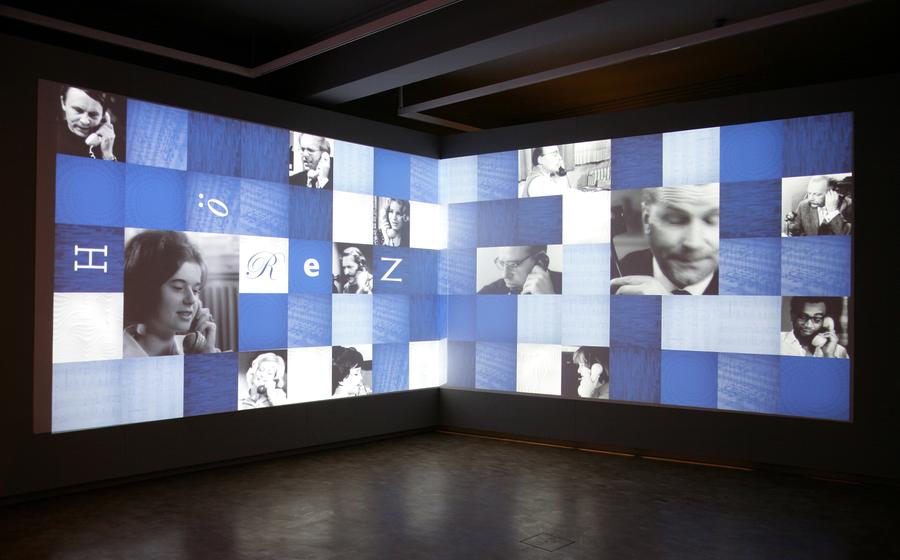
Museum of Communication (Museum für Kommunikation)
- The Museum of Communication: A Journey Through the History of Communication
- Exploring the Museum's Collection
- Interactive Exhibits and Workshops: Bringing Communication History to Life
- The Museum's Historical Context
- The Museum's Educational Programs
- The Museum's Research and Conservation Efforts
- Temporary Exhibitions and Special Events
- The Museum's Accessibility and Facilities
- The Museum's Impact on the Local Community
- The Museum's International Recognition
- The Museum's Digital Presence
- The Museum's Future Plans and Developments
- Personal Anecdotes and Experiences
- Insider Tip: Hidden Gem of the Museum
The Museum of Communication: A Journey Through the History of Communication
Nestled in the heart of Nuremberg, Germany, the Museum of Communication, or Museum für Kommunikation, takes visitors on an enthralling journey through the evolution of human communication. The museum's collection delves into the diverse methods and technologies that have shaped our ability to connect, from ancient writing systems to modern digital communication.
The Museum of Communication stands out as a unique institution dedicated solely to the history of communication. It houses a comprehensive collection of artifacts, exhibits, and interactive displays that bring to life the stories behind the technologies that have transformed our societies. From the invention of the printing press to the rise of the internet, the museum offers a comprehensive exploration of the milestones that have shaped our communication landscape.
Interactive exhibits and hands-on experiences make learning about communication history an engaging and immersive experience for visitors of all ages. Whether you're sending Morse code messages, trying your hand at early printing techniques, or exploring virtual reality displays, the museum offers a unique blend of education and entertainment.
As a cultural and educational institution, the Museum of Communication plays a vital role in preserving and promoting our communication heritage. Its collection serves as a valuable resource for scholars, researchers, and anyone interested in the history of human communication. The museum's exhibitions and educational programs aim to foster a deeper understanding of the role communication has played in shaping our societies and cultures.
Exploring the Museum's Collection
The Museum of Communication houses an extensive collection of artifacts and exhibits that trace the development of communication across centuries and cultures. From ancient writing systems, such as cuneiform tablets and hieroglyphics, to the latest digital communication technologies, the museum's collection is a treasure trove of communication history.
Among the highlights of the collection is the Gutenberg Bible, a groundbreaking innovation in printing technology. This 15th-century book, printed using movable type, revolutionized the dissemination of information and marked a turning point in communication history. The museum also displays a remarkable collection of early telephones, from the first experimental models to the iconic rotary phones that shaped modern communication.
The museum's collection is organized into thematic sections, each focusing on a different aspect of communication. Visitors can explore the evolution of writing, the development of printing technologies, the rise of telegraphy and telephony, and the impact of digital communication on our lives. Interactive displays and multimedia presentations bring the exhibits to life, allowing visitors to engage with the material in a meaningful way.
Interactive Exhibits and Workshops: Bringing Communication History to Life
The Museum of Communication in Nuremberg not only boasts a remarkable collection of artifacts but also offers a range of interactive exhibits and workshops that bring communication history to life. Visitors of all ages can engage with the museum's collection through hands-on activities and experiments, making learning about communication an immersive and interactive experience.
One of the highlights of the museum's interactive exhibits is the "Communication Lab," where visitors can experiment with different communication technologies and methods. From sending Morse code messages to trying out early telephone models, the lab provides a hands-on experience of the evolution of communication.
Another popular exhibit is the "Printing Press Workshop," where visitors can learn about the history of printing and create their own prints using traditional techniques. This hands-on activity offers a unique insight into the impact of the printing press on communication and the spread of knowledge.
The museum also offers a variety of workshops and educational programs tailored to different age groups and interests. These workshops cover a wide range of topics, from cryptography and coding to the history of the internet. Through these interactive sessions, visitors can delve deeper into the fascinating world of communication and gain a deeper understanding of its impact on society.
Whether you're a history buff, a tech enthusiast, or simply curious about the evolution of communication, the Museum of Communication's interactive exhibits and workshops offer a unique and engaging experience for visitors of all ages.
The Museum's Historical Context
Nuremberg, the city that houses the Museum of Communication, holds a significant place in the history of communication. The city's strategic location and vibrant cultural scene have made it a crucial hub for communication and trade throughout the centuries.
During the Middle Ages, Nuremberg flourished as a center of commerce and craftsmanship. Its central location in Europe made it a meeting point for merchants, travelers, and scholars from various regions. This exchange of ideas and goods led to the development of new communication technologies and practices.
The city's role in communication was further enhanced by the invention of the printing press by Johannes Gutenberg in the 15th century. Nuremberg quickly became a leading center for printing and publishing, and the Gutenberg Bible, printed in the city in 1455, revolutionized the dissemination of information.
The Reformation, a religious movement that swept through Europe in the 16th century, also had a profound impact on communication in Nuremberg. The city became a stronghold of the Protestant movement, and the printing press played a crucial role in spreading Martin Luther's ideas and writings.
The Museum of Communication, nestled in the heart of Nuremberg's historic center, reflects the city's rich communication heritage. The museum's collection and exhibits showcase the significant role that Nuremberg has played in the development of communication technologies and practices, from ancient writing systems to modern digital communication.
The Museum's Educational Programs
The Museum of Communication is committed to providing educational opportunities for visitors of all ages. It offers a range of educational programs and workshops tailored to different age groups, from preschoolers to adults. These programs focus on specific communication topics or themes, such as the history of writing, the development of the telephone, or the impact of social media.
Schools and groups can book guided tours of the museum, which are led by experienced educators who provide insights into the museum's collection and the history of communication. The museum also offers hands-on workshops and activities, where visitors can experiment with different communication methods and learn about the science behind communication technologies.
Teachers and educators can access a variety of resources and materials on the museum's website, including lesson plans, activity sheets, and online exhibitions. These resources are designed to help educators incorporate communication history into their classroom teaching.
The Museum of Communication's educational programs are an essential part of its mission to preserve and promote the understanding of communication. Through these programs, the museum provides opportunities for lifelong learning and helps visitors to develop critical thinking skills and a deeper appreciation for the role of communication in society.
The Museum's Research and Conservation Efforts
The Museum of Communication is not only a repository of historical artifacts but also a hub for research and conservation in the field of communication. The museum's dedicated team of researchers works tirelessly to preserve and document the museum's collection, ensuring that these valuable artifacts are available for future generations to study and appreciate.
The museum also collaborates with other institutions, both nationally and internationally, to conduct research projects and share knowledge about communication history. These collaborations foster a vibrant exchange of ideas and contribute to the advancement of the field.
One of the museum's key research areas focuses on the impact of new technologies on communication practices and societal change. By studying the history of communication, researchers gain insights into how new technologies have shaped our interactions with each other and with the world around us.
The museum's conservation efforts are equally important, as they ensure that the artifacts in its collection are preserved for posterity. The museum's conservators use specialized techniques to stabilize and restore artifacts, ensuring that they remain in good condition for display and study.
Through its research and conservation efforts, the Museum of Communication plays a vital role in preserving and understanding our communication heritage. The museum's contributions to the field of communication studies are invaluable, helping us to better understand the role of communication in shaping our world.
Temporary Exhibitions and Special Events
The Museum of Communication in Nuremberg is not just a static collection of artifacts and displays; it's a dynamic and ever-evolving institution that hosts a variety of temporary exhibitions and special events throughout the year. These exhibitions showcase cutting-edge developments in communication technology, explore new perspectives on communication history, and provide a platform for contemporary discussions on the role of communication in society.
Visitors to the museum can expect to encounter a diverse range of temporary exhibitions, from interactive installations that explore the latest trends in digital communication to thought-provoking displays that examine the impact of communication on culture and society. The museum also hosts regular lectures, workshops, and panel discussions featuring experts from various fields, offering visitors the opportunity to engage with leading thinkers and practitioners in the world of communication.
One of the highlights of the museum's temporary exhibition program is the annual "Communicative Objects" exhibition, which showcases innovative and experimental communication projects from around the world. This exhibition is a must-see for anyone interested in the latest trends in communication design and technology.
Special events at the museum offer visitors the chance to experience the museum in a unique and memorable way. From themed tours and family days to interactive workshops and live performances, there's always something new and exciting happening at the Museum of Communication.
Whether you're a history buff, a tech enthusiast, or simply someone who's curious about the role of communication in our world, the Museum of Communication's temporary exhibitions and special events offer something for everyone. Be sure to check the museum's website or social media channels for the latest information on upcoming events and exhibitions.
The Museum's Accessibility and Facilities
The Museum of Communication is committed to providing a welcoming and accessible environment for all visitors. The museum is wheelchair accessible, with ramps and elevators throughout the building. Visitors with disabilities can also borrow wheelchairs and other assistive devices from the museum's front desk.
Families with young children will appreciate the museum's family-friendly facilities. There is a children's play area where kids can let off steam and learn about communication in a fun and interactive way. The museum also offers a variety of family-friendly programs and workshops throughout the year.
The Museum of Communication is located in the heart of Nuremberg, making it easy to reach by public transportation or on foot. There are several parking garages nearby for those who are driving.
Whether you are a history buff, a tech enthusiast, or simply someone who is curious about the world of communication, the Museum of Communication is a must-visit destination. With its comprehensive collection, engaging exhibits, and educational programs, the museum offers a unique and unforgettable experience for visitors of all ages.
The Museum's Impact on the Local Community
The Museum of Communication is not just a tourist attraction; it is also an integral part of the local community in Nuremberg. The museum serves as a valuable cultural and educational resource for residents of all ages. It offers a variety of educational programs and workshops tailored to different age groups, focusing on specific communication topics or themes. Schools and groups are encouraged to visit the museum to learn about the history of communication and its impact on society. The museum also collaborates with local schools and organizations to develop educational initiatives and programs. By engaging with the local community, the Museum of Communication fosters cultural exchange, promotes dialogue, and contributes to the city's cultural vitality.
In addition to its educational role, the museum also contributes to Nuremberg's tourism and economy. As a popular tourist destination, the museum attracts visitors from around the world, who come to learn about the history of communication and experience its interactive exhibits. The museum's presence in Nuremberg helps to boost the city's economy by generating revenue and creating jobs. Furthermore, the museum's collaborations with local businesses and organizations create opportunities for partnerships and cross-promotion, benefiting both the museum and the local community.
The Museum's International Recognition
The Museum of Communication in Nuremberg has garnered international recognition for its exceptional contributions to the field of communication. Renowned for its comprehensive collection, innovative exhibitions, and engaging educational programs, the museum has established itself as a leading institution in the global dialogue on communication.
Collaborations with museums and academic institutions around the world have fostered cross-cultural understanding and facilitated the exchange of ideas and expertise. The museum's dedication to preserving and showcasing communication heritage has earned it a reputation for excellence, attracting visitors from across the globe.
Through its international outreach, the museum plays a vital role in promoting cross-cultural understanding and fostering global dialogue on the impact of communication in our societies. Its contributions to the field have been widely acknowledged and celebrated, solidifying its status as a premier destination for exploring the history, evolution, and significance of communication in human civilization.
The Museum's Digital Presence
In the digital age, the Museum of Communication has embraced the power of technology to extend its reach and impact beyond the walls of its physical space. Through its comprehensive website, visitors can explore virtual exhibitions, access educational resources, and delve into the museum's vast collection from the comfort of their own homes.
The museum's website serves as a treasure trove of information, offering in-depth articles, interactive timelines, and multimedia presentations that delve into various aspects of communication history. Virtual exhibitions, such as "The History of Writing" or "The Evolution of Telecommunications," provide immersive experiences that allow users to explore artifacts, read stories, and watch videos, creating a virtual journey through the annals of communication.
Social media platforms play a vital role in the museum's digital strategy, connecting it with a global audience and fostering a sense of community among communication enthusiasts. Through Facebook, Twitter, Instagram, and YouTube, the museum shares behind-the-scenes glimpses, highlights new acquisitions, announces upcoming events, and engages in conversations with followers.
The museum's digital initiatives are not limited to passive content consumption. It actively encourages visitors to interact and participate through online quizzes, polls, and discussions, creating a dynamic space for knowledge sharing and exchange of ideas. Virtual workshops and webinars provide opportunities for remote learning and engagement, making the museum's educational programs accessible to a broader audience.
The museum's website and social media channels are not mere replicas of its physical exhibits but rather complementary platforms that offer unique experiences and perspectives. They serve as gateways to the museum's vast collection, resources, and expertise, ensuring that the museum's mission of preserving and promoting communication history extends far beyond its physical walls.
The Museum's Future Plans and Developments
The Museum of Communication is constantly evolving to stay relevant and engaging for visitors. Ongoing expansion and renovation projects are underway to enhance the museum's facilities and provide new experiences for visitors. Plans for new exhibitions and educational programs are in the works, ensuring that the museum remains a dynamic and vibrant institution.
The museum is committed to innovation and embracing new technologies to enhance the visitor experience. Interactive exhibits, virtual reality experiences, and digital storytelling are some of the ways the museum is exploring to bring communication history to life in new and exciting ways.
The museum's vision for the future is to be a leading global institution for communication studies and education. It aims to continue promoting cross-cultural understanding and dialogue through communication and to inspire future generations to explore and understand the ever-changing landscape of communication.
Personal Anecdotes and Experiences
My first visit to the Museum of Communication was a revelation. As a lifelong lover of history and communication, I was immediately drawn to the museum's unique focus on the evolution of this essential human activity. The interactive displays and hands-on experiences brought the history of communication to life, allowing me to experience firsthand the challenges and advancements that have shaped our ability to connect with one another.
One particularly memorable exhibit was a replica of Gutenberg's printing press. As I stood before this monumental invention, I couldn't help but marvel at its impact on the spread of knowledge and the democratization of information. The museum's collection of early telephones also fascinated me, reminding me of the ingenuity and perseverance of the pioneers who laid the foundation for our modern communication systems.
Beyond the artifacts themselves, the museum's educational programs and workshops left a lasting impression on me. I attended a workshop on the history of cryptography, which gave me a newfound appreciation for the complex art of encoding and decoding messages. The museum's commitment to education and outreach is truly commendable, and I left feeling inspired and eager to learn more about the fascinating world of communication.
Insider Tip: Hidden Gem of the Museum
Beyond the well-known highlights, the Museum of Communication holds hidden treasures that are waiting to be discovered. One such gem is the "Secret Codes and Encryption" exhibit, tucked away in a secluded corner of the museum. This interactive display takes you on a journey through the fascinating world of cryptography, from ancient ciphers to modern encryption techniques.
Here, you can try your hand at deciphering secret messages, using tools and methods employed by spies and codebreakers throughout history. Experience the thrill of solving puzzles and unlocking hidden meanings, as you learn about the vital role that cryptography has played in warfare, diplomacy, and everyday life.
Whether you're a history buff, a cryptography enthusiast, or simply someone who enjoys a good puzzle, this hidden gem is not to be missed. So, take your time exploring the museum, and don't forget to seek out this intriguing exhibit for a truly unique and memorable experience.
